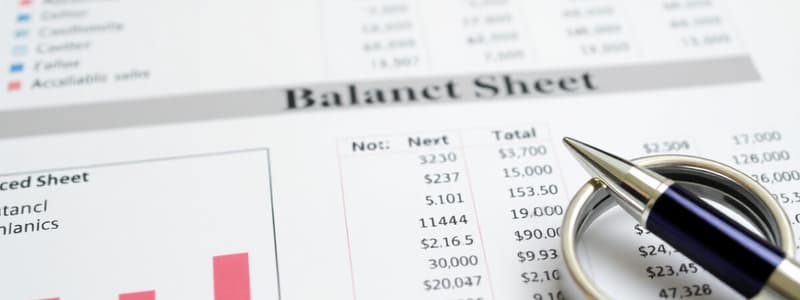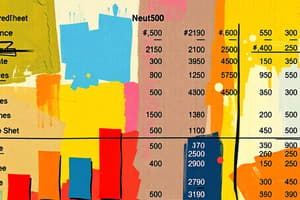Podcast
Questions and Answers
Which of the following is a limitation of the balance sheet?
Which of the following is a limitation of the balance sheet?
- Judgments and estimates are used.
- All of these (correct)
- Many items that are of financial value are omitted.
- Current fair value is not reported.
The balance sheet is useful for analyzing all of the following except:
The balance sheet is useful for analyzing all of the following except:
- Solvency.
- Liquidity.
- Financial flexibility.
- Profitability. (correct)
Balance sheet information is useful for all of the following except to:
Balance sheet information is useful for all of the following except to:
- Compute rates of return.
- Analyze cash inflows and outflows for the period. (correct)
- Evaluate capital structure.
- Assess future cash flows.
Balance sheet information helps with all of the following except:
Balance sheet information helps with all of the following except:
Identify a limitation of the balance sheet that does not also limit the income statement:
Identify a limitation of the balance sheet that does not also limit the income statement:
The balance sheet is a basis for all of the following except:
The balance sheet is a basis for all of the following except:
Which criticism is not normally directed at a balance sheet prepared using current accounting and reporting standards?
Which criticism is not normally directed at a balance sheet prepared using current accounting and reporting standards?
How long until an asset is realized or converted into cash is referred to as what?
How long until an asset is realized or converted into cash is referred to as what?
The net assets of a business are equal to:
The net assets of a business are equal to:
What is the correct order to present current assets?
What is the correct order to present current assets?
Assets are classified as current or noncurrent based on:
Assets are classified as current or noncurrent based on:
The period of time normally required by an accounting entity to convert cash invested in inventory back into cash, or the period to convert receivables back into cash is the period to classify assets as current or noncurrent,
The period of time normally required by an accounting entity to convert cash invested in inventory back into cash, or the period to convert receivables back into cash is the period to classify assets as current or noncurrent,
AG Inc. made a $15,000 sale on account with the following terms: 1/15, n/30. If the company uses the net method to record sales made on credit, how much should be recorded as revenue?
AG Inc. made a $15,000 sale on account with the following terms: 1/15, n/30. If the company uses the net method to record sales made on credit, how much should be recorded as revenue?
AG Inc. made a $15,000 sale on account with the following terms: 1/15, n/30. If the company uses the gross method to record sales made on credit, what is/are the debit(s) in the journal entry to record the sale?
AG Inc. made a $15,000 sale on account with the following terms: 1/15, n/30. If the company uses the gross method to record sales made on credit, what is/are the debit(s) in the journal entry to record the sale?
AG Inc. made a $15,000 sale on account with the following terms: 2/10, n/30. If the company uses the net method to record sales made on credit, what is/are the debit(s) in the journal entry to record the sale?
AG Inc. made a $15,000 sale on account with the following terms: 2/10, n/30. If the company uses the net method to record sales made on credit, what is/are the debit(s) in the journal entry to record the sale?
Flashcards
Balance Sheet Limitation
Balance Sheet Limitation
A financial statement limitation is the fair value isn't reported.
Uses of a Balance Sheet
Uses of a Balance Sheet
Balance sheets help with liquidity, solvency, and financial flexibility.
Use of Balance Sheet Information
Use of Balance Sheet Information
Balance sheet information is useful for computing return rates and evaluating capital structure.
Use of Balance Sheet Information
Use of Balance Sheet Information
Signup and view all the flashcards
Balance Sheet vs. Income Statement
Balance Sheet vs. Income Statement
Signup and view all the flashcards
Criticisms of a Balance Sheet
Criticisms of a Balance Sheet
Signup and view all the flashcards
Liquidity
Liquidity
Signup and view all the flashcards
Net Assets of a Business
Net Assets of a Business
Signup and view all the flashcards
Presentation Order of Current Assets
Presentation Order of Current Assets
Signup and view all the flashcards
Classifying Assets as Current or Noncurrent
Classifying Assets as Current or Noncurrent
Signup and view all the flashcards
Cash Equivalent
Cash Equivalent
Signup and view all the flashcards
Compensating Balance
Compensating Balance
Signup and view all the flashcards
What is Not Cash
What is Not Cash
Signup and view all the flashcards
Net Accounts Receivable
Net Accounts Receivable
Signup and view all the flashcards
Restricted Cash
Restricted Cash
Signup and view all the flashcards
Study Notes
Chapter 4 Practice Questions
- Limitations of the balance sheet include the omission of many items of financial value, the use of judgments and estimates, and the fact that current fair value is not reported.
- The balance sheet is useful for analyzing liquidity, solvency, and financial flexibility, but not profitability.
- Balance sheet information helps compute rates of return, evaluate capital structure, and assess future cash flows, but not analyze cash inflows and outflows for the period.
- Balance sheet data can assess a company's risk, liquidity, and financial flexibility, but not determine free cash flows.
- A limitation specific to the balance sheet, not shared with the income statement, is the valuation of items at historical cost.
- The balance sheet provides a basis for computing rates of return, evaluating capital structure, and assessing liquidity and financial flexibility, but not for determining the increase in cash due to operations.
- A criticism typically not directed at a balance sheet prepared using current accounting and reporting standards is the extensive use of separate classifications.
- The amount of time expected to elapse until an asset is realized or converted into cash is liquidity.
- The net assets of a business equal total assets minus total stockholders' equity.
- The correct order to present current assets is: cash, accounts receivable, inventories, prepaid items.
- Assets are classified as current or noncurrent based on conversion to cash within the operating cycle or one year, whichever is longer.
- Classifying assets as current or noncurrent depends on the time needed to convert cash invested in inventory back into cash, or 12 months, whichever is longer.
- DLD Company's cash provided by operating activities in 2012 was $54,500; the net income was $55,000, accounts receivable increased by $3,000, accounts payable increased by $1,000, building decreased by $4,000, depreciation expense increased by $1,500, and bonds payable increased by $8,000.
- Harding Corporation should report $530,000 as cash provided by operating activities; net income was $450,000, depreciation expense was $140,000, and the increase in accounts receivable was $60,000.
- Sauder Corporation reports $340,000 cash from operating activities; the net income was $300,000, depreciation expense was $70,000, and the increase in accounts receivable was $30,000.
- Packard's cash debt coverage ratio is 0.94: net cash from activities $235,000, average current liabilities $150,000, average long-term liabilities $100,000, dividends declared $60,000, capital expenditures $110,000, payments of debt $35,000.
- Packard's free cash flow is $65,000: net cash from operating activities is $235,000, average current liabilities is $150,000, average long-term liabilities is $100,000, dividend paid is $60,000, capital expenditures is $110,000, payments of debt is $35,000.
- Pedigo's cash debt coverage ratio is 1.10: net cash provided by operating activities is $275,000, average current liabilities is $150,000, average long-term liabilities is $100,000, dividends paid is $60,000, capital expenditures is $110,000, payments of debt is $35,000.
- Pedigo's free cash flow is $105,000: net cash from operating activities $275,000, average current liabilities $150,000, average long-term liabilities $100,000, dividends paid $60,000, capital expenditures $110,000, payments of debt $35,000.
Chapter 5 Practice Questions
- The balance in a savings account paying 6% annually with an initial $25,000 deposit after two years will be $28,090, given a future value factor of 1.06 for one period.
- Dunston Company will receive $500,000 in 7 years: the future receipt is discounted at 10%, its present value is $256,580.
- Milner Company will have $1,070,584 in the investment fund after 5 years: the company invests $800,000 today at 6% with no withdrawals.
- Barber Company will receive $1,500,000 in 7 years, and if the interest rate is 10%, the present value of the $1,500,000 receipt is $769,740.
- To have $1,140,000 after 12 years on a $452,000 investment, Charlie must earn an interest rate of approximately 8%.
- With a 4% annual interest rate, it will take approximately 18 years for Ethan's $240,000 investment to grow to $486,000.
- To determine the maturity value of the certificate, the future value of one concept would be used.
- Based on the provided options, Jerry should choose the signing bonus of $26,000 payable after one year of employment.
- To determine the monthly payment, the future value of an ordinary annuity concept would be used.
- This is a future value of an ordinary annuity problem.
- Charlie Corp. will pay $56,640 in interest over the term of the loan.
- The amount of $1 left on deposit for 8 years with interest at 4% compounded quarterly would be found using 32 periods at 1%.
- To determine the amount to deposit today to reach $10,000 in three years, calculate $10,000 ÷ 1.260.
- The amount available in three years if $3,000 is put in a savings account today is $3,000 x 1.260.
- The amount in a bank account three years from now if $6,000 is invested each year for four years, with the first investment made today, is ($6,000 × 1.260) + ($6,000 × 1.166) + ($6,000 × 1.080) + $6,000.
- With $4,000 put in a savings account today, the amount available in six years is $4,000 x 1.080 x 1.469.
Chapter 6 Practice Questions
- Becky's net realizable value of receivables at December 31, 2017, is $970,000 with net sales of $8,000,000, accounts receivable of $1,000,000, and a debit balance of $2,000 in the allowance for doubtful accounts; 3% of accounts receivable are estimated to be uncollectible.
- The balance in the allowance for doubtful accounts after the year-end adjustment is $456,000.
- The adjustment for uncollectible accounts is $8,600: Debit: $56,000, Accounts receivable: $172,000, Credit: $1,700,000, Allowance for doubtful accounts: $3,040.
- Smithson's bad debt expense for 2017 is $27,600, accounts written off are $21,600, accounts previously written off are $6,300, accounts receivable balance $600,000, accounts receivable balance $720,000, and 5% of accounts receivable will prove to be uncollectible.
- Shelton should report accounts receivable at a net amount of $132,800; accounts receivable is $140,000, the allowance for doubtful accounts is $7,200, and sales discounts are $4,800.
- Postdated checks and I.O.U.'s are not considered cash for financial reporting.
- All of the listed options may be included under the heading of “cash” except savings account balance.
- A compensating balance is the minimum deposit required to be maintained in connection with a borrowing arrangement.
- Cash restricted for plant expansion is reported under the non-current assets section of the balance sheet.
- A cash equivalent is a short-term, highly liquid investment convertible into known cash amounts with insignificant risk of interest rate changes due to its near maturity.
- Kaniper should report cash and cash equivalents of $35,800: cash in bank $30,000, petty cash $300, short-term paper with maturity of 2 months $5,500, postdated checks $1,400.
- Lawrence should report cash of $22,000: cash in bank $22,000, restricted cash $4,000, and bank overdraft $2,000.
- Steinert should report cash and cash equivalents of $43,700: cash in bank $35,000, petty cash $500, short-term paper $8,200, postdated checks $2,100.
- AG Inc. should record $14,850 as revenue: terms 1/15, n/30, and uses the net method.
- AG Inc. should debit Accounts Receivable for $15,000: terms 1/15, n/30, and uses the gross method.
- AG Inc. should debit Accounts Receivable for $14,700, made on the terms 2/10, n/30, and uses the net method.
Studying That Suits You
Use AI to generate personalized quizzes and flashcards to suit your learning preferences.



